Carl Zeiss Jena 7x40
Hälfte eine EDFZwar nie als Monokular gefertigt, zeigt dies gut aufbereitete Hälfte eines VEB Zeiss Jena EDFs 7x40 (s.a. A. Köhlers Website) was für ein gutes monokulare Fernrohr dies gewesen wäre. Mit der rötlichen magenta Vergütung erhält man ein gutes für einige (Ostblock-)Optiken häufigen leicht gelblichen Bild, das durch die der Strahlenbeständigkeit der Glaselemente und der Filterung der blendenden Blauanteile im Licht herrührt und so ein Beobachten bei grellen Himmel oder stark refelktierenden Flächen (Wasser) effektiv ist. Die Hälfte hat eine Strichplatte mit verschiednenen Visiereinteilungen (s. Bild). Das Sehfeld ist 7,5° oder 131/1000m. Das Okular hat einen Dioptrieneinstellung von plus bis minus 7, markiert bei 5 und mit einem erhabenen Punkt bei Null. Das Monokular hat ein Schmidt-Pechan-Prisma, ein grün lackiertes Metallgehäuse mit angegossener Trageriemenöse und Gummiummatnelung sowie einer Objektivschutzkappe. Das EDF (Einheitsdoppelfernrohr) wurde in den 1980er Jahren produziert. |
Half of an EDFAlthough it was never issued as a monocular this well refurbished half of a VEB Zeiss Jena EDF 7x40 (also see A. Köhlers Website) show what an excellent monocular telesocpe this wpould hae been. With its reddish magenta coating you get a good image - slightly yellow tinted often typical for some East-block optics - which is caused by the glass elemnts being resistant against radiation damage and filtering the blue blinding light spectrum. This allows obvserving during glaring skies or reflecting surfaces like water. The half has a reticle with differnt scales (cf. photo). The field of view is 7.5° or 131/1000m. The eyepeice has a dioptre adjustment ranging from plus to minus 7 being marked at 5, and with a raised dot at zero. The monocular comes with a Schmidt-Pechan prism, a green lacquered metal body with a cast-in strap lug and a rubber armouring as well as an objective protection cap. The EDF (Einheitsdoppelfernrohr = unified double telescope) was made in the 1980s. |
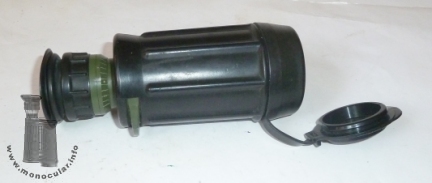
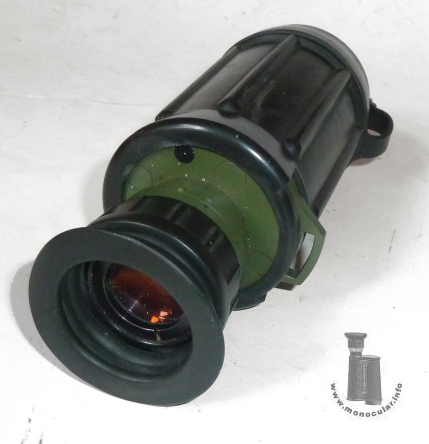
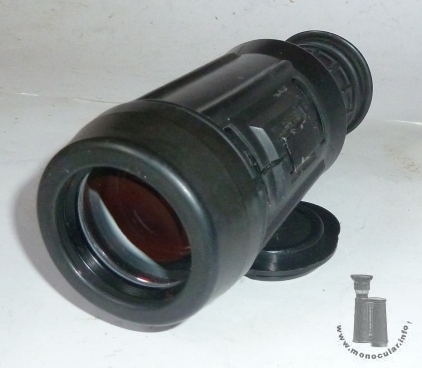
| Die Strichplatte hat zwischen den großen Strichen ein Intervall von 10m auf 1000m Entfernung und in der unteren Skala eine Entfernungsschätzung für Objekte mit bekannter Höhe von 2,5m. Die Objektive sind in dialytischer (getrennt aeingebauter zweilinsiger) bzw. Teleobjektiv-Bauweise. Dies verkürzt die Baulänge. Die Augenmuschel ist aus Weichgummi und lässt sich Ziehharmonika-artig zusammendrücekn. |
The logner division lines of the reticle stand for a 10m interval at 1000m. The lwoer scale can be used for estimating distances when an object of 2.5m height is known. The obejctives are built in a dialytic matter, i.e. an objective with two lenses postitioned in some distance to each other, or work lieka telephoto-lens. This shortens the length of the isntrument. The soft rubeer eyecup is flexible like a bellows. |
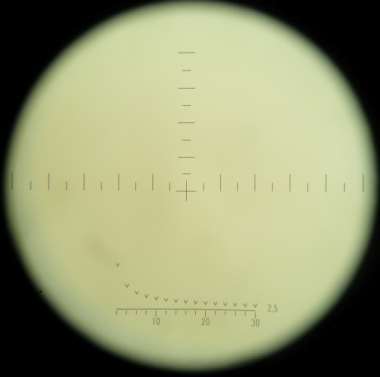
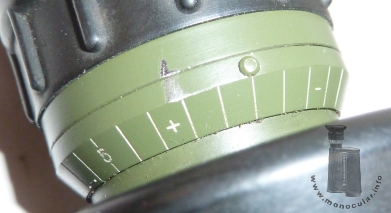
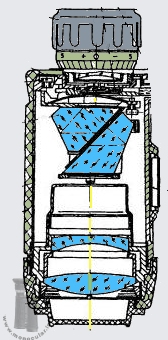
| Die 7x40 Hälfte wiegt 444g. Es ist 150-155mm lang, am Objektivende und Tubus 60mm, vor der Trageriemneöse 56mm, am Okularstück 31mm, vorm Fokussierungsgummring 38mm im Durchmesser und die Augenmsuchelkrempe 50mm im Durchmesser. | The 7x40 half weighs 444g. It is 150-155mm long. The objective end and tube are 60mm, the body part next to the strap lug is 56mm, the eyepiece 31mm, the metal part near the focusing ring 38mm, and the eyecup 50mm in diameter. |
Fotos: Zeun

